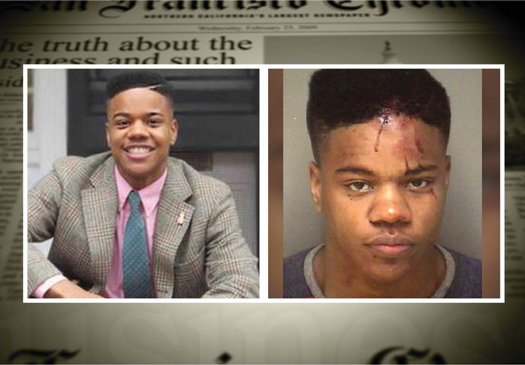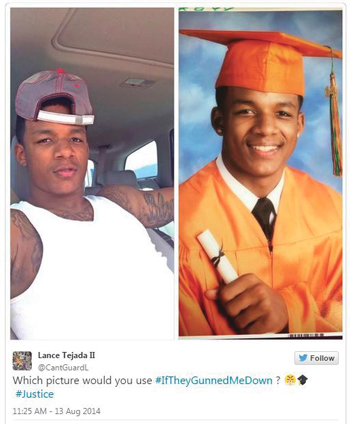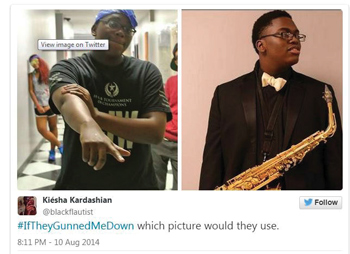
The bloodied face of Martese Johnson, a 20-year-old student at the University of Virginia, looked like a throwback to the 1960s as he lay down on a sidewalk surrounded by White officers. But it wasn’t 1960 it was 2015 and the systems of White supremacy quickly went to work. The media spewed the account of police officers and once again another young Black male was painted as a problem, a menace to society.
Nearly every time a Black male is accused of a crime, the police version becomes the unquestioned story though the accused is supposed to be innocent until proven guilty and the media is supposed to be a watchdog and counter powerful institutions.
The media, however, gladly partners with police in spreading lies based on one-sided, false accounts from officers who have everything to gain by lying, in particular when the accused is beaten and bloody.
Officers don’t say, “We just decided to teach him a lesson so we beat him to a bloody pulp.” They don’t say, “Well the rule is, if you run and we catch you, you get a beatdown for making us run. If we have to send the dog after a suspect, the dog gets rewarded by biting the suspect.”

The lies are told to discredit innocent people who don’t have access to media or people not seen as credible sources by media. In the incident with Martese, his sterling record made the university president, a university vice president and the governor all pause. The governor called for an investigation and the president of the University of Virginia and the vice president for diversity said flatly that Martese was a victim of brutality.
Fairness and Accuracy in Media lists some questions to ask when dealing with the media: Who are the sources? Is there a lack of diversity? From whose point of view is the news reported? Are there double standards? Do stereotypes skew coverage? What are the unchallenged assumptions? Is the language loaded? Is there a lack of context? Do the headlines and stories match? Are stories on important issues featured prominently?
The early stories spread the lie that Martese had been approached because of fake i.d. and a problem entering a bar. Lies. The young man never used a false i.d. and the bar owner described his encounter with Martese as pleasant and the young man was not intoxicated.
The media always calls for “reserving” judgment and parsing every word when a police officer is accused of anything, but the opposite is never true. Any accusation by an officer is credible and any denial by a suspect is questionable.
Part of the problem is numbers of Blacks in the shrinking journalism industry remains small and those who make decisions remain overwhelmingly White and Black owners are few.
According to the American Society of News Editors and the Center for Advanced Social Research 2013 survey, “There are about 38,000 full-time daily newspaper journalists at nearly 1,400 newspapers in the United States. That’s a 2,600-person decrease from last year’s 40,600. Of the 38,000 employees, about 4,700 or 12.37 percent are racial minorities.”

“Newsrooms also continue to be about two-thirds male, another trend that has been consistent for years. … Currently, minorities make up 37.02 percent of the U.S. population; that number will increase to 42.39 percent by 2025, according to the U.S. Census Bureau,” the survey found.
Ninety percent of newsroom supervisors from participating news organizations were White according to the survey. The 2012 diversity report for the Radio Television Digital News Association found 86 percent of television news directors and 91.3 percent of radio news directors were White.
So as the country grows darker, the all-powerful news media and its gatekeepers grow Whiter and Whiter.
“According to the 2010 United States Census, non-whites comprise nearly 35 percent of the U.S. population, but the study finds that people of color fill only 12 percent of the newsroom managerial positions at stations owned by ABC, Allbritton Communications, Belo Corporation, CBS, Cox Media Group, Fox Television Stations, Gannett, Hearst, Journal Broadcast, Lin Media, Media General, Meredith, NBC, Nexstar Broadcasting, E.W. Scripps Company, Post-Newsweek, Raycom Media, Sinclair Broadcasting and Tribune,” the 2012 the National Association of Black Journalists’ Television Newsroom Management Diversity Census found.
Recent studies show people of color own less than 8 percent of all commercial radio stations and just more than 3 percent of all commercial television stations, NABJ said.
Diversity is even lacking at journalism startups online, NABJ has noted. “In light of demographic changes that show the White, male audience is dwindling, diversity in newsrooms is good business. It just makes sense,” the group said in 2014, the same year the Washington Post reported so-called “minorities” are the majority in 22 of the 100 largest U.S. metropolitan regions.
In the end, the media misreporting and media lies are about power and a bias ingrained in a country that has never seen a value for Black life outside of Black lives serving White interests. Lying about Black people is as American as apple pie and this country has a voracious appetite when it comes to the domination, dehumanization and devaluation of Black people. The media is no exception.












